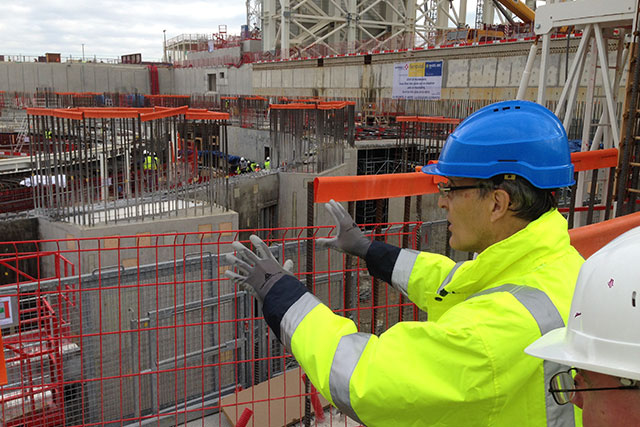
Fourteen MIT students joined an international group of 70 in Marseille, France, in January 2016 for a weeklong workshop on multiscale porous materials and their applications in the nuclear power industry.
Offered for the first time as an official MIT class during MIT’s Independent Activities Period, the Marseille Winterschool provided training in all facets of these materials, ranging from advanced microscopy and spectroscopy techniques to nanomechanical testing of stiffness, strength, and fracture properties.
“This program offers MIT students a rich introduction to the use of complex porous materials that are everywhere in everyday life—in soils, cement, and [other components] critical to virtually all industrial energy processes,” says Roland Pellenq, senior research scientist in MIT’s Department of Civil and Environmental Engineering (CEE) and one of the co-organizers of the Winterschool.
Marseille Winterschool was founded four years ago to give graduate students and postdocs around the world the chance to learn about porous materials at multiple scales—from nanometer to micron—in applications from the lab up to energy resource management. Each year, the program has focused on the impact of such materials within a different domain, including global warming, infrastructure, and gas shale operations.
This program offers MIT students a rich introduction to the use of complex porous materials that are everywhere in everyday life.
Roland Pellenq
“The theme this year is porous materials around the nuclear energy cycle,” says CEE Professor Franz-Josef Ulm, one of the instructors for the class (another MIT instructor was CEE Professor John R. Williams). “Porous materials are absolutely critical for the nuclear cycle, from shielding [radiation] up to the ultimate safe storage of these materials.”
A highlight of the week was a trip to ITER, a multibillion-dollar experimental fusion reactor that is under construction in France thanks to a collaboration of 35 nations. “Fusion is an exciting prospect for the future of energy; the physics behind it is amazing, but I didn’t know much about it,” says Gerald Wang, a third-year graduate student in mechanical engineering who attended Winterschool. “I was really impressed by the herculean engineering task they are undertaking and felt very lucky to have been on site to see these things.”
Students toured the facility and had a seminar with ITER’s director-general, Bernard Bigot. “It was an inspiration to hear what he had to say about the role ITER will play in the future of energy,” says physics major Alexander Andriatis ‘18, one of just two MIT undergraduates to participate in Winterschool. “It was really amazing to be able to see this cutting-edge research and multibillion-dollar investment from countries from around the world.”
Organized by MIT and CNRS (the French National Center for Scientific Research), Winterschool featured lectures by experts from MIT, Georgetown University, Aix-Marseille University, and the University of Paris. “I was very impressed with the enthusiasm and participation of the MIT students during the series of lectures, and I think everyone got a lot out of the very dense Winterschool program,” Pellenq says.
Winterschool was founded with the support of CNRS, Aix-Marseille University (through the AMIDEX Foundation), and France’s national science foundation, the Agence Nationale de la Recherche (through its Laboratory of Excellence Interdisciplinary Center on MultiScale Materials for Energy and Environment).
MIT’s participation was supported by funding from the MIT Energy Initiative and MIT-France, which together supplied fellowships for seven of the 14 students. The MIT students came from CEE, chemical engineering, mechanical engineering, nuclear science and engineering, physics, and materials science and engineering.
To build on this success, Ulm says he hopes to expand Winterschool in the future. “We are in discussions with different partners to create an education infrastructure for training the next generation of researchers working on porous materials as [these materials] become more and more important in fields from batteries to oil and gas to geothermal applications,” he says. “This would be a fantastic enrichment of MITEI’s educational outreach, for MIT students and far beyond MIT’s boundary.”
This article appears in the Spring 2016 issue of Energy Futures.